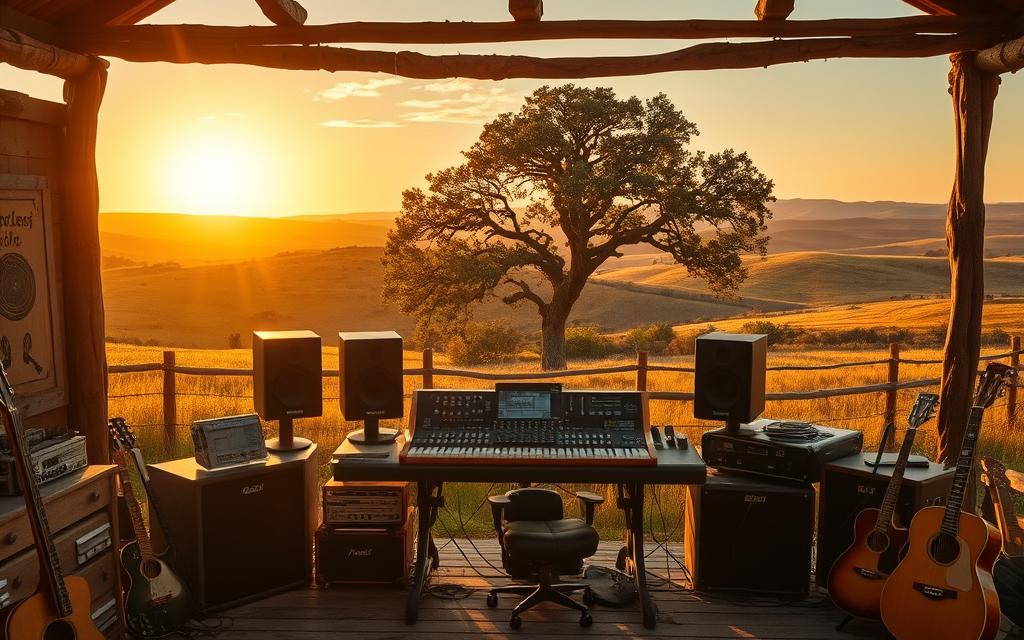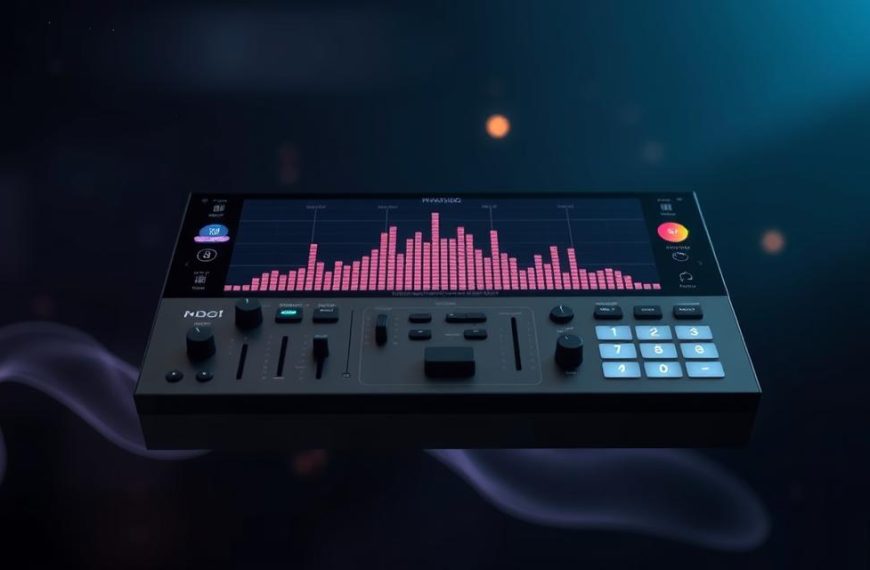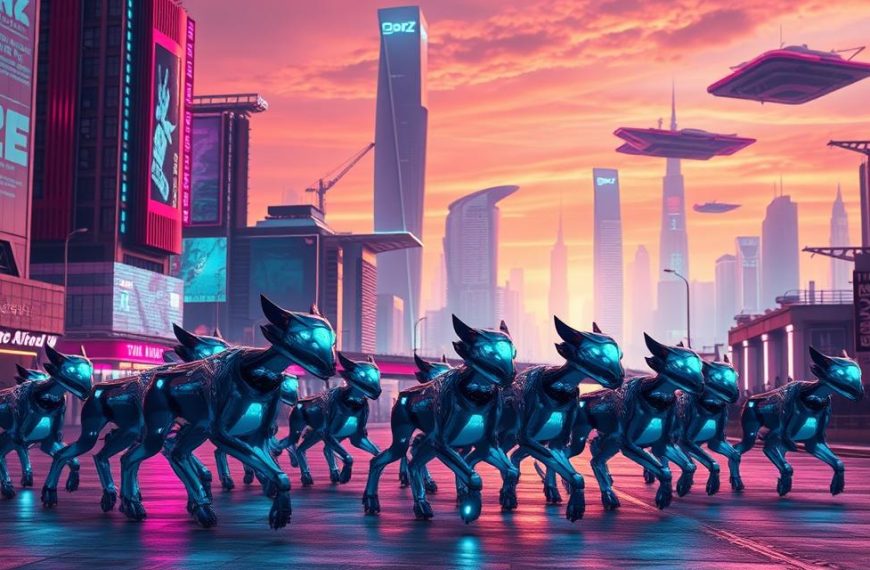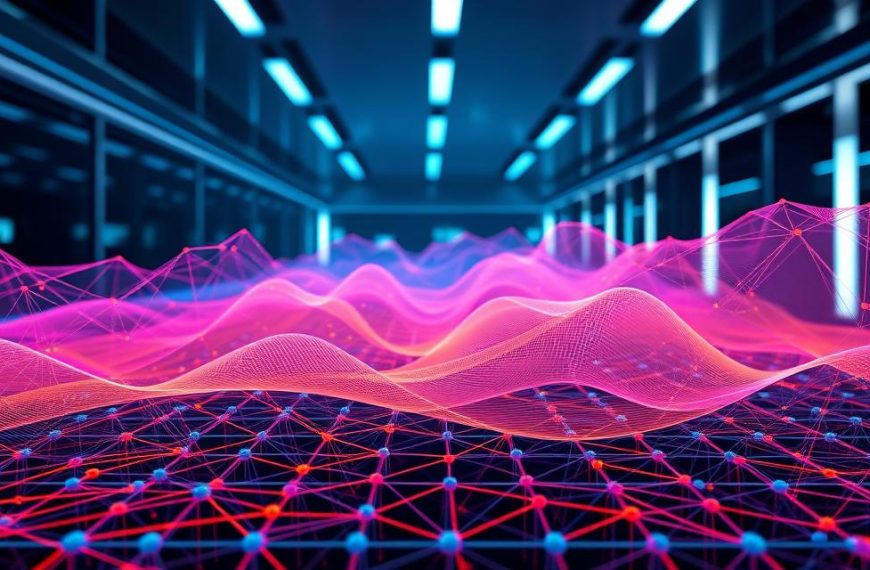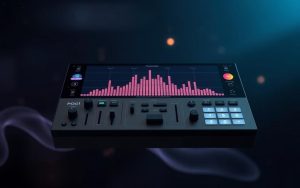Country music is special because of its storytelling and unique sound. It’s a big challenge for AI systems to get it right. They need to capture the music’s emotional depth and authenticity.
We looked into how AI music generation technology works with country music. We wanted to know if it could really capture the essence of country. This includes the heartache, twang, and stories that make country music so loved.
The results were both surprising and revealing. They show what AI can do and what it can’t. This experiment gives us a real look at how far AI has come in creating music.
The Rise of AI in Creative Industries
Artificial intelligence has changed creative fields worldwide. It has moved from being new tech to being key tools. The music industry is a great example of this change. AI now helps with making music, producing it, and even performing it.
AI’s Expanding Role in Music Production
Today’s AI tools do more than just automate music making. Sites like Amper Music, AIVA, and OpenAI’s MuseNet can create original songs in many styles. They look at lots of music to find patterns and styles.
These tools can now make whole songs, including picking instruments and arranging music. Big recording studios use AI to get ideas for chords and lyrics. This helps in making music.
AI has gotten better at understanding emotions and music styles. This is a big step from old tools that just followed math patterns. Now, AI can try to capture the soul of music.
Why Country Music Presents a Unique Challenge
Country music is hard for AI to get right. It needs real stories, cultural touches, and true feelings. AI finds it hard to match these.
Country songs often come from personal stories and local culture. They need to capture human feelings in a way AI finds tricky. AI is good at following rules but struggles with deep emotions.
Country music also has special instruments like pedal steel guitar and banjo. These instruments need a deep understanding of how to play them. AI must learn these nuances to sound real.
AI faces big challenges in keeping country music true to its roots. The table below shows how AI does in different music areas:
| Music Element | Pop Music | Electronic | Country Music |
|---|---|---|---|
| Melody Generation | Excellent | Excellent | Good |
| Lyrical Authenticity | Good | Fair | Challenging |
| Genre Instrumentation | Very Good | Excellent | Difficult |
| Emotional Resonance | Fair | Fair | Very Difficult |
| Structural Accuracy | Excellent | Excellent | Good |
Country music is a big test for AI’s creativity. It needs more than just tech skills. It needs to understand culture and feelings, which AI is working on.
Even with these challenges, AI is getting better at country music. Mixing old music with new tech opens up new ways to make music.
The Process of Asking AI to Make a Hit Country Song
Making music with AI needs a careful plan. It mixes technical details with creative ideas. This part explains how to make a real country song with smart algorithms.
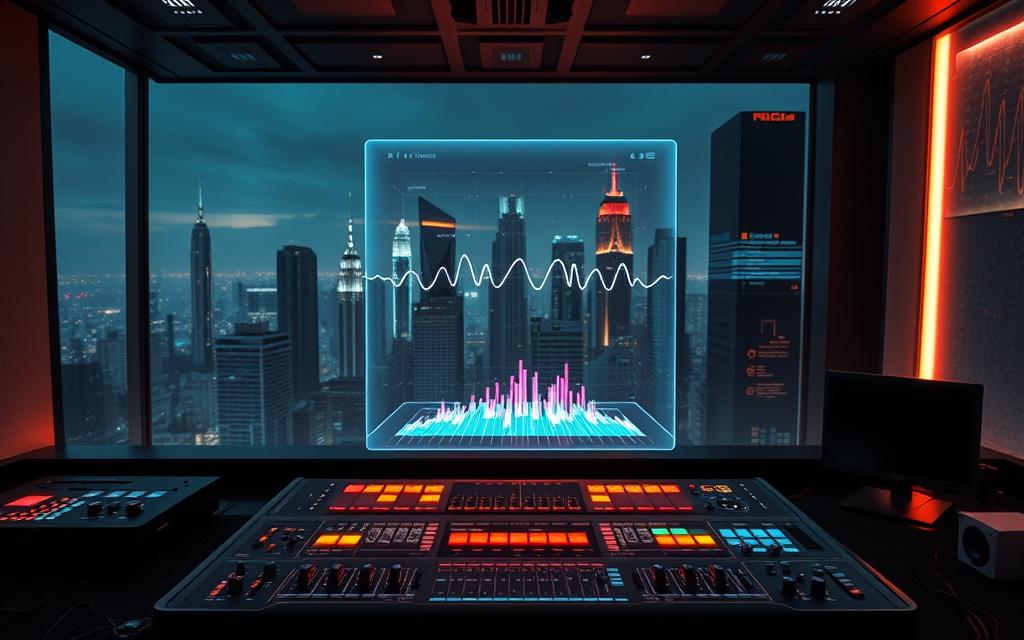
Selecting the Right AI Tool for Music Generation
Choosing the right AI tools is key for music projects. Not all tools are good for all genres. So, picking the right one for country music is very important.
Criteria for Choosing an AI Platform
Several important factors helped pick the best AI tools for this project:
- Genre specialisation: Tools that are good at country music were chosen first
- Output quality: We looked at sample tracks for their sound quality
- Customisation options: Being able to set specific details was a must
- Technical compatibility: The tools had to work well with music production
- User interface: Easy-to-use design was important for creative direction
These factors made sure the chosen tools could handle country music’s special needs. They also had to produce music that sounded ready for the radio.
Input Parameters and Creative Brief
Good AI music making needs clear input parameters. The brief had both technical and emotional details.
Key Elements of a Country Song Brief
The brief had key parts of real country music:
- Thematic elements: It included themes like heartbreak and rural life
- Musical structure: It followed the verse-chorus-verse format with breaks
- Instrumentation requirements: It needed steel guitar, fiddle, and acoustic rhythm
- Lyrical themes: It had real emotional stories told in a conversational way
- Tempo and key specifications: It was in moderate 4/4 timing and major keys
These details gave the AI a clear guide but also let it be creative. Finding the right balance between detail and freedom was key for great results.
Analysing the AI-Generated Song Structure
We’ve created an AI country song and now we’re diving into its structure. This look shows us how AI sees and builds music in the country style.
Verse, Chorus, and Bridge Breakdown
The AI song follows a pattern seen in many popular tunes. The verses tell a story, a key part of country music.
Each verse adds to the story, keeping the theme strong. The AI knows how to grow a story over verses.
The chorus is the song’s heart, with catchy lines that grab listeners. The AI made a memorable hook that holds the song together.
The bridge is where the song breaks new ground. The AI brings in new sounds and feelings, adding depth before wrapping up.
Comparison to Traditional Country Song Formats
Looking at the AI’s song against traditional country, we see both similarities and differences. The AI gets the basics of country music right.
Country songs usually stick to a certain pattern. The AI’s song follows this pattern but also adds its own twist.
| Structural Element | Traditional Country Format | AI-Generated Structure |
|---|---|---|
| Introduction Length | 8-16 bars typically | 12 bars with pedal steel emphasis |
| Verse-Chorus Pattern | Often V-C-V-C-B-C | V-C-V-C-B-C (identical) |
| Bridge Placement | After second chorus typically | Traditional placement maintained |
| Outro Approach | Fade or definitive ending | Extended instrumental fade |
The table shows the AI gets the core of country music right. It’s great at keeping the verse-chorus flow.
But, the AI does make some changes. It adds longer instrumental bits, giving the song a fresh feel while staying true to country roots.
In conclusion, the AI’s song shows a deep understanding of country music. It stays true to the genre while bringing in new ideas.
Lyrics Deep Dive: Themes and Language
Exploring AI-generated lyrics offers a peek into how machines understand and mimic human storytelling. The AI’s creation both surprises and meets our expectations about its creativity.
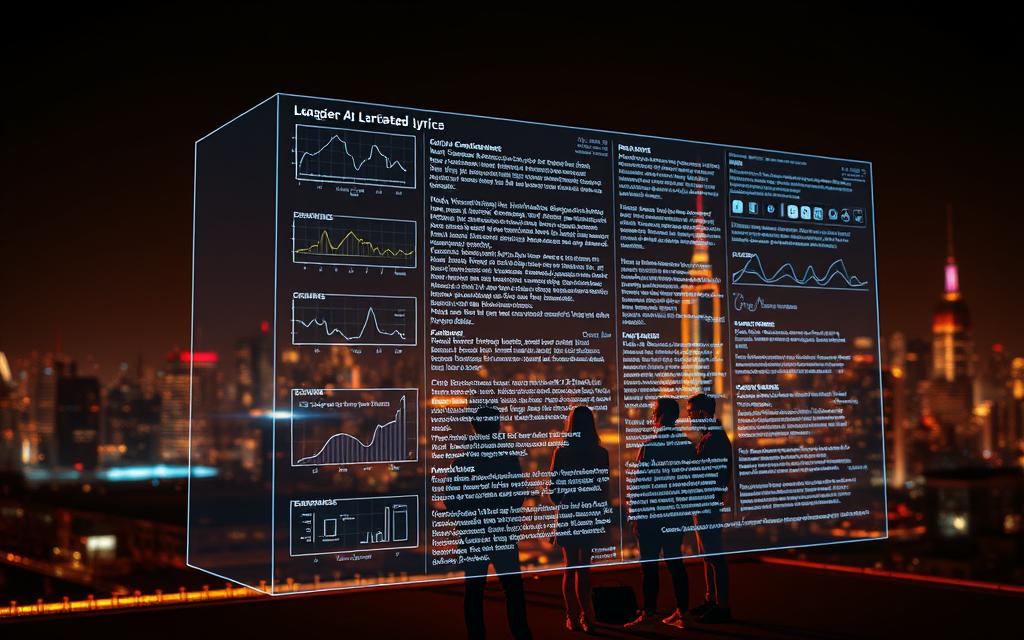
Common Country Tropes in AI Output
The algorithm showed a deep understanding of country music’s themes. It often used rural images, like:
- Pickup trucks on dusty backroads
- Small-town diners and Friday night lights
- Farm life references and agricultural metaphors
Heartbreak was a major theme, with the AI weaving stories of lost love and self-reflection. It included traditional country elements, such as:
- Working-class struggles and blue-collar pride
- Family values and generational connections
- Simple pleasures and nostalgic reminiscence
The AI organised these elements well. It made stanzas that stayed true to their themes but varied details.
Authenticity and Emotional Resonance
Did the AI’s lyrics truly touch our hearts? The composition is technically skilled but lacks deep emotion.
Some phrases, like:
“The porch light’s stil burning, though you’re long gone”
show the AI’s knack for creating moving images. Yet, other parts felt too formulaic, using common rhymes and phrases.
The emotional impact varied. The chorus hit harder than the verses, showing the AI’s focus on catchy hooks. The bridge tried to add depth but lacked real emotion.
Looking closely at the language, we see the AI’s emotional approach. It preferred:
- Direct emotional statements over subtle implication
- Familiar metaphors over new imagery
- Consistent rhyme schemes over natural speech
While the AI’s lyrics are technically good, they sometimes feel forced. They capture country music’s surface but lack the true emotion of its best works.
Musical Elements: Melody and Instrumentation
The technical side of our AI-made country song shows how AI works with music. It looks at how AI handles instruments and melodies. These are key parts that make country music sound unique.
AI’s Handling of Typical Country Instruments
The AI did a great job picking and arranging country instruments. The song includes:
- Acoustic guitar as the beat
- Pedal steel guitar with sliding sounds
- Fiddle adding country flair
- Banjo with its own picking style
The music production AI mixed these sounds well. Each instrument has its own place in the sound, keeping it clear and country.
The digital versions of these country instruments are a big step forward. Even though they’re not real, they sound like the real thing to most people.
| Instrument | AI Implementation | Authenticity Score (1-10) |
|---|---|---|
| Acoustic Guitar | Excellent strumming patterns | 9 |
| Pedal Steel | Convincing slide effects | 8 |
| Fiddle | Appropriate ornamentation | 7 |
| Banjo | Good picking technique | 8 |
Melodic Patterns and Harmonic Progressions
The song’s melody sticks to country rules but also tries new things. It uses major keys and sometimes mixes in other sounds for more feeling.
Some key melodic patterns are:
- Small steps in verses, big leaps in choruses
- Back-and-forth between vocals and instruments
- Traditional “twang” in the vocal melody
The harmonic progressions follow classic country paths. But it also tries out new chord changes to keep things interesting.
This AI-generated music shows AI can learn about music genres. It studied many country songs to get the melodic patterns and harmonic progressions right.
As seen in this analysis of AI songwriting steps, AI’s music skills are getting better fast. The music production AI not only copied country sounds but also put them together in a way that makes sense.
The song’s bridge is very clever, moving to a relative minor before going back to the main key. This shows the AI is getting better at creating emotional moments in music.
Strengths and Weaknesses of the AI Creation
We’ve looked closely at the AI-made country song. It shows both great skills and areas where it falls short in automated songwriting.
This review gives us a clear view of where AI shines in music and where human touch is needed. Let’s dive into the details.
Where the AI Excelled
The AI was very good at technical stuff. It made songs that sounded right.
It built songs with clear parts and rhymes. It kept the same rhythm all through.
It picked the right instruments for country music. It used things like acoustic guitar and fiddle well.
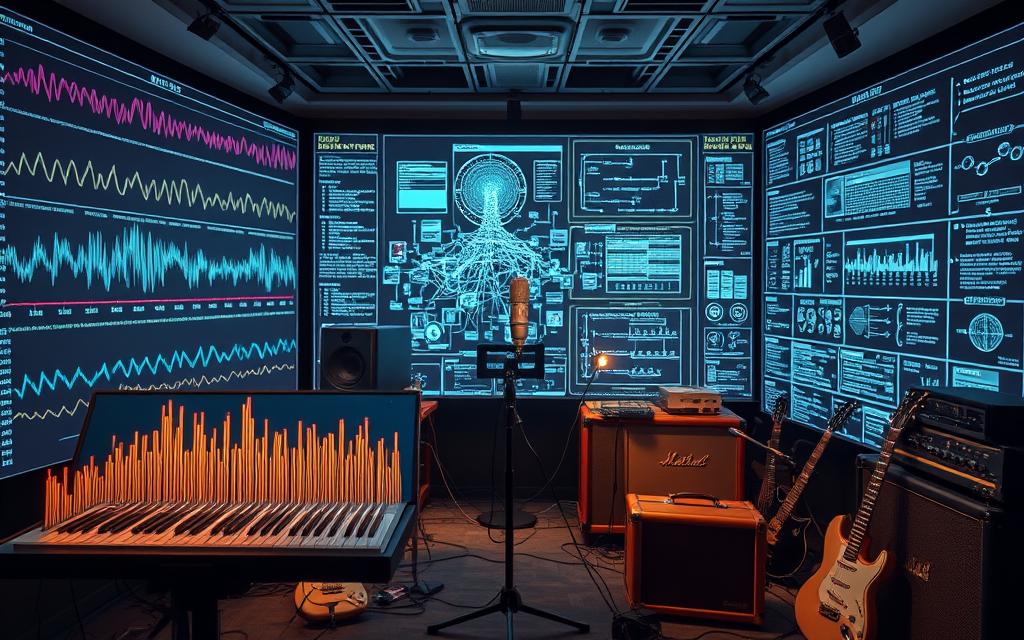
The lyrics had common country music themes. It used words and phrases that fit the genre.
It handled music parts well. It made harmonies and melodies that sounded good.
Limitations and Areas for Improvement
Even with its strengths, the AI song lacked emotional depth and originality. The lyrics didn’t feel real, like in great country songs.
There are a few key areas where automated songwriting needs to get better:
- Emotional authenticity in lyrics
- Creative originality
- Understanding of cultural context
- Adding emotional depth to music
- Keeping up with current music trends
The AI had trouble making stories that moved people. It could follow rules but didn’t tell stories like real country songs do.
It mostly copied what’s already out there. It didn’t bring new ideas to country music.
| Strength Area | Performance Level | Improvement Needed |
|---|---|---|
| Structural Coherence | Excellent | Minimal |
| Technical Execution | Very Good | Moderate |
| Emotional Depth | Poor | Significant |
| Creative Innovation | Fair | Substantial |
| Genre Authenticity | Good | Moderate |
It also had trouble with cultural references and staying current. The AI didn’t get the deeper cultural links that humans do.
This shows that automated songwriting needs human help. The best songs come from working together with AI and human creativity.
AI is great for technical tasks but needs human touch for emotions and creativity. It’s better as a tool than a replacement for human songwriters.
Implications for the Future of Music
AI music tools are more than just new tech. They could change how we make, share, and enjoy music. This raises big questions about art’s value and how we create in the digital world.

Potential Impact on Songwriters and Artists
AI music tools bring both challenges and chances for music pros. Many worry that AI might cut down on the need for human composers. It could shake up how we make money and work in music.
But, many artists see AI as a tool to help, not replace them. Producers might use it for ideas or to get past creative blocks. This could open up music making to more people.
Experts think we’ll see a mix of old and new ways. Artists will use AI for parts but keep their own touch. This mix could bring new sounds and ideas we never thought of before.
“AI won’t replace artists, but artists using AI will replace those who don’t adapt to new technologies.”
Ethical Considerations in AI-Generated Art
AI music raises big ethical questions. Copyright is a big worry. Laws struggle to deal with music made by AI without human help.
Authenticity is also a big issue. People want real human feeling in music. AI music might lose that special connection between artist and listener.
Being open about AI music is key. Should we know when music is made by AI? How do we give credit to both humans and AI? These are questions everyone needs to think about.
| Aspect | Human Composers | AI Systems | Hybrid Approach |
|---|---|---|---|
| Creative Process | Emotional experience-driven | Algorithm pattern-based | Combines both approaches |
| Originality | Unique personal expression | Pattern recombination | Enhanced creative possibilities |
| Production Speed | Varies with inspiration | Rapid generation | Efficient workflow |
| Emotional Depth | Genuine human connection | Simulated emotional cues | Human-curated emotion |
The debate on AI vs human composers is growing as tech gets better. Most agree it’s not about replacing humans, but changing how we do things. The music world needs new rules that value human creativity and tech progress.
It’s important to think about ethics in this new world. We need clear rules for who gets credit, copyright, and how open we should be. This way, we can keep art real while exploring new ideas.
Conclusion
This experiment shows AI is getting better at making country music. It understands song structure, instruments, and lyrics well. Tools like the TopMediai AI Music Generator are both skilled and easy to use.
But, AI music lacks emotional depth and original lyrics. It’s good at the technical side but not at telling stories like great country songs. This shows where AI can get better.
The future of AI music looks bright. We expect it to get better at feeling and being creative. This change will likely change how artists and producers work.
AI music tools are helpful, not a replacement for human creativity. They help with ideas and building a technical base. The mix of AI and music is getting more interesting.
This technology’s growth opens up new possibilities for AI music in all genres. Country music’s challenges have taught us a lot about AI’s strengths and weaknesses.

